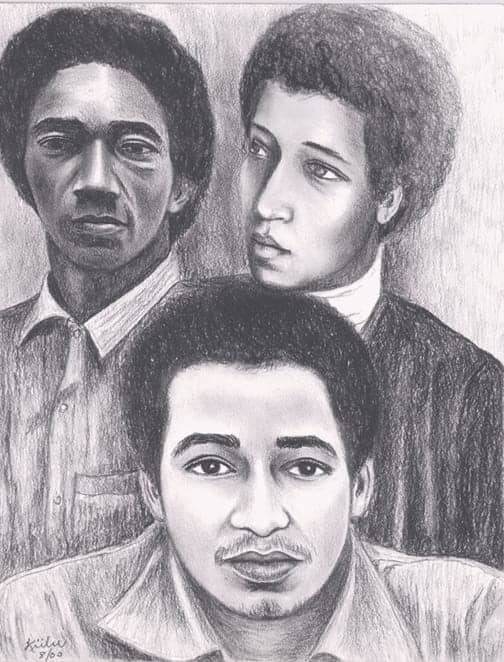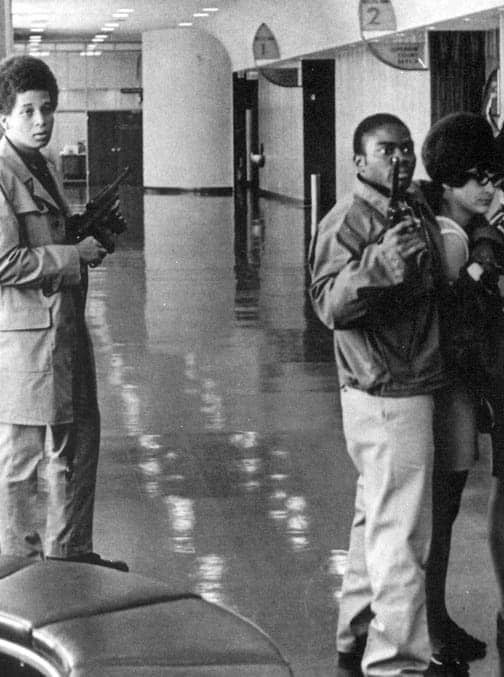... reports from multiple prisoners in the Restricted Housing Unit (RHU) at State Correctional Institution (SCI) Rockview in central Pennsylvania that John Carter, a 32-year-old state prisoner from Pittsburgh, was killed by prison staff during a cell extraction on April 26, 2012. A cell extraction is a procedure where six guards suit up in riot gear armed with pepper spray, a stun shield and taser, and enter a prisoner’s solitary confinement cell and forcibly subdue, handcuff and shackle him.
According to witness accounts, prison guards filled Carter’s solitary confinement cell with an extraordinary quantity of pepper spray prior to opening his cell door, tasering and assaulting him. One report stated that the incident began after Carter protested being deprived of food.
Another prisoner reported that during the cell extraction he could hear Carter say, “Alright, alright, I’m coming out. Let me cuff up.” The same report stated that he then heard a guard say, “No, you should’ve come out when we asked you the first time,” and that the guards continued to spray Carter, “turning his cell into a gas chamber.”
No evidence of foul play?
Well, a whole lot of folks, led by John's family, beg to differ. They do see evidence of "foul play."
Read the posts below from San Francisco Bay View and I wouldn't be a bit surprised if you join those who think there just might have been a wee bit of "foul play."
July 25, 2012
by Human Rights Coalition
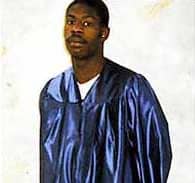
John Carter
According to multiple witness accounts, staff at Pennsylvania’s SCI (State Correctional Institution) Rockview killed John Carter, a 32-year-old man from Pittsburgh, during a cell extraction in the prison’s solitary confinement unit on April 26, 2012. The declaration of one witness, esteemed writer André Jacobs, follows this introduction.
John Carter had been held in solitary confinement in several different prisons for the last eight to 11 years, where he had developed a reputation as a jailhouse lawyer willing to speak out against the rampant and endless cycle of human rights violations in prisons throughout the Pennsylvania Department of Corrections. A fellow prisoner wrote of Carter: “He was a person of integrity. He did not believe in abuse of others, especially the abuse of prisoners from prison guards. If he could help someone in understanding the law, he was there. And he had a lot of patience with others, especially the mentally impaired.”
A cell extraction is a procedure where six guards in riot gear, armed with pepper spray, a stun shield and a taser, enter a prisoner’s solitary confinement cell and forcibly subdue, handcuff and shackle him. According to witness accounts, on the day of his death, prison guards filled Carter’s solitary confinement cell with an extraordinary quantity of pepper spray prior to opening his cell door, tasering and assaulting him.
One report stated that the incident began after Carter protested being deprived of food. Another prisoner reported that during the cell extraction, he could hear Carter say: “All right, all right, I’m coming out. Let me cuff up.” The same report stated that he then heard a guard say, “No, you should’ve come out when we asked you the first time,” and that the guards continued to spray Carter, “turning his cell into a gas chamber.”
A fellow prisoner wrote of Carter: “He was a person of integrity. He did not believe in abuse of others, especially the abuse of prisoners from prison guards. If he could help someone in understanding the law, he was there. And he had a lot of patience with others, especially the mentally impaired.”
In a story published by Solitary Watch, “
Death in Pennsylvania Solitary Confinement Cell Raises Questions,” Hannah Taleb writes: “In 1995, John Carter took part in a robbery that resulted in the murder of one man in Pittsburgh, Pa. He was 16 at the time and was convicted of second-degree felony murder. In Pennsylvania, which has more juvenile lifers than any other state, his conviction meant a mandatory life sentence without the possibility of parole. (Under the Supreme Court’s June 25 ruling, in
Miller v. Alabama, that mandatory life sentences without parole for juveniles were unconstitutional, Carter would likely have had his sentence reconsidered, had he lived to see the day.) …
“Before his death Carter had spent the last 10 to 11 years in solitary. According to prisoner reports, he had been known to break the rules of his unit in order to share food, hygiene items and writing utensils with newcomers to his block and adamantly used both the grievance process and legal system to challenge acts of abuse and retaliation by prison staff. …
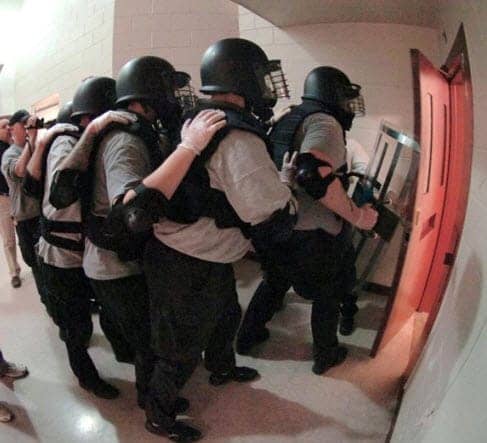
Guards prepare for a cell extraction at a Pennsylvania prison. – Photo: Butch Comegys, The Times-Tribune
“(O)fficials first claimed that no cell extraction took place the day of Carter’s death, then that there was an extraction but no video footage, and finally that an extraction took place but the footage may have been ‘damaged.’ …
Under the Supreme Court’s June 25 ruling, in Miller v. Alabama, that mandatory life sentences without parole for juveniles were unconstitutional, Carter would likely have had his sentence reconsidered, had he lived to see the day.
“No statements have been made by the State Police since May 10. Toxicology reports from the coroner’s office are still forthcoming more than two months after John Carter’s death.
“John Carter’s family is not satisfied with the investigation thus far and are resolved to find justice in his death. They arranged for a second autopsy and filed a criminal complaint with Center County District Attorney Stacy Parks-Miller in June. As a response, the DA’s office is now overseeing the investigation carried out by the State Police but has released no further information on its progress.”
An interview by Hannah Taleb with John Carter’s sister, Michelle Williams, for Rustbelt Radio can be heard here:
Audio clip: Adobe Flash Player (version 9 or above) is required to play this audio clip. Download the latest version here. You also need to have JavaScript enabled in your browser.
Go to
http://hrcoalition.org/node/223 to read more documents HRC has gathered in relation to the murder of John Carter. They are provided to raise awareness, to garner support for his family seeking justice, and to inspire action against deliberate torture and killing of prisoners inside Pennsylvania prisons.
T
he Human Rights Coalition is a group of predominately prisoners’ families, ex-prisoners and some supporters. Our ultimate goal is to abolish prisons. We seek to empower prisoners’ families to be leaders in prison organizing, while reducing the shame of having a loved one in prison. We want to make visible to the public the injustice and abuse that is common throughout our judicial and prison systems and eventually end those abuses. Contact the Human Rights Coalition at 4134 Lancaster Ave., Philadelphia, PA 19104, (215) 921-3491 or Info@hrcoalition.org. Excerpts from Hannah Taleb’s story were added to the HRC account by Bay View staff.
Declaration of André Jacobs on the murder of John Carter
André Jacobs, being duly sworn, declares the following under the penalty of perjury:
Background
On April 26, 2012, prisoner John Carter was murdered by prison guards in SCI-Rockview’s Restricted Housing Unit (RHU). The murder was in retaliation for Carter protesting what began as guards Sherman, Hellman and another guard denying him his dinner meal and Lts. Sutton and Davis refusing to rectify it upon being informed of it by myself, Carter and other prisoners.
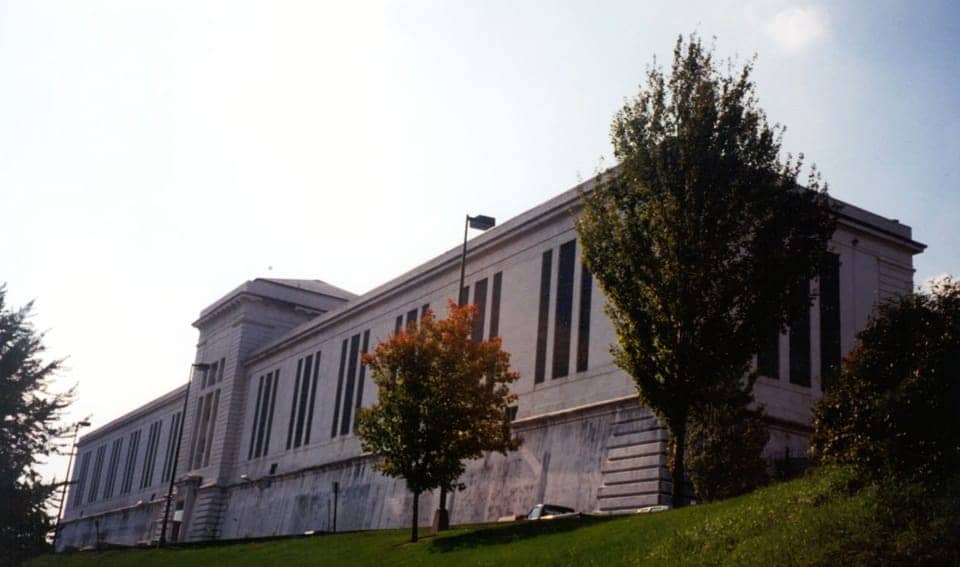
SCI Rockview, known as Pennsylvania’s “Big House,” was the first prison in the state to use the electric chair. This is the main building.
The pretextual dispute was whether Carter’s 21-meal foodloaf punishment was over, i.e., whether Carter was, in fact, entitled to a food tray – he was, in fact. He received his first foodloaf on April 19 at lunchtime. A universal thing called mathematics dictates that his 21st foodloaf was issued at lunchtime on April 26.
“Foodloaf” is an inedible brick-like slab of cold rice, oatmeal and other unknown items issued to prisoners who allegedly abused a food tray or item. It is a tactic to starve prisoners.
Description of incident
Carter covered his cell door window in protest of being denied his dinner meal. He allegedly threw a liquid outside his cell door after being denied a remedy. It is unclear how this is possible since, after the first claim that he threw something from his cell, he was put in A1-2 cell, which is specifically designed to prevent the throwing of items out of the cell at any time.
During the collection of our food tray, guard Sherman said to me, “Your buddy’s going down tonight,” while smiling. I have a non-contact policy with Sherman because he previously assaulted me and denied me a food tray also.
Carter was never ordered beforehand to remove the door covering. Instead, Lt. Sutton and Lt. Davis mounted an extraction team, often referred to as the “goon squad” or “winga turtles” because they wear helmets, vests, protective face, arms and leg armor. They are also armed with batons, electroshock riot shields, handheld electroshock devices and O.C. spray (Oleoresin Capsicum, commonly known as pepper spray).
Before the guards proceeded down the range in formation, Lt. Sutton turned on the extremely loud fan.
André Jacobs: “He’s turning the fan on so we can’t hear what’s going on!”
Robert Hankins: “Turn the fan off!”
Terrell Rhem: “The fan ain’t been on all day. Now you turn the fan on?”
The fan they are supposed to use after the cell extraction/spraying is over is the exhaust fan to suck the O.C. out of the atmosphere. The fan used served only to make noise, knowing that all RHU prisoners’ witness accounts in such situations are based on what we can hear. And it was turned on long before it was officially declared that Carter would be sprayed.
Guards: “Carter! Come to your door and cuff up! Carter! Come to your door and cuff up!”
Carter remained unresponsive the entire time. The guards began spraying O.C. into the cell. I and others screamed that they were spraying beyond the “2-3 second burst” dictated by Department of Corrections (DOC) policy. They continued to spray.
Israel Torres: “They got two different types of spray! Two different types!”
The fan used served only to make noise, knowing that all RHU prisoners’ witness accounts in such situations are based on what we can hear. And it was turned on long before it was officially declared that Carter would be sprayed.
After spraying a voluminous amount of O.C. into Carter’s cell, the guards tried to enter for attack but realized that the door was jammed.
Guards: “Carter! Turn on your light, come to the door and cuff up! Uncover your door!”
By this time, they had sprayed so much O.C. that he was probably afraid to come out of his safe space. Even if he wanted to surrender they had discouraged him by spraying excessive O.C. He probably already knew they were coming to kill him.
A number of times, the extraction team left to regroup or make phone calls. They eventually returned with the maintenance man. After the maintenance man tried unsuccessfully to unjam the door, they sprayed more O.C. in the cell. By now, they were using sticks and poles to push items from Carter’s door in order to get as much O.C. into the cell as possible.
André Jacobs: “Y’all would rather do all of this than give that man his food tray, huh? He’s hungry!”
The guards sprayed O.C. into Carter’s cell at least 10 times knowing they could not get into the cell. In all of my years of witnessing and participating in cell extractions, I’ve never ever witnessed so much O.C. used on one prisoner. It had to be enough to subdue an elephant.
The murder
They ripped the door off like madmen. Six guards entered the cell as the camera man stood outside, supposedly audio- and visually recording the assault.

SCI Rockview is an old prison, built in 1912. This 1940 view was printed as a postcard.
John Carter’s last words, as reported by Carter’s neighbor, Corey Blanchard: “Get off me!” or “Get off my fingers!”
Anthony Autwell, Carter’s other neighbor: “I heard them banging him around on the wall and floor. They were saying, ‘Stop resisting,’ as usual. I heard Carter say something like, ‘Stop twisting my fingers.’ They electro-shocked him at least seven times.”
While the guards had on gas masks, they left Carter pinned to the ground without any protective gear on a cell floor full of O.C. for several minutes. He was then dragged out of the cell by his knees with his head dragging along the floor, out into the hallway between A1 and A2 showers.
It was reported to me that Carter was not handcuffed or shackled when he was removed from his cell. This is troubling, since they spent so much time inside Carter’s cell doing what? The official plan in any cell extraction is to take the person to the ground and handcuff and shackle him. It’s like they knew they were going in Carter’s cell to kill him.
Lt. Sutton: “Cut the camera off!”
Camera man: “Do you want me to keep filming?”
Lt. Sutton: “No! Cut it off!”
Nurses Julie, Bob and possibly Amanda were all loosely present in the RHU. None of them attempted to intervene or caution the guards about the amounts of O.C. being used.
It was reported to me that Carter was not handcuffed or shackled when he was removed from his cell. This is troubling, since they spent so much time inside Carter’s cell doing what? The official plan in any cell extraction is to take the person to the ground and handcuff and shackle him. It’s like they knew they were going in Carter’s cell to kill him.
After about 10-15 minutes, I heard a female scream, “Call 911!” It was at least 10-15 minutes longer before trained medical personnel arrived. I personally heard them try to revive him only once.
Top prison officials, including Superintendent Lamas and Deputy Horton, are witness to Carter’s death. Carter was wheeled out of the RHU without any definite declaration as to whether he was dead or alive.
Cory Blanchard: “I solemnly swear to you, he had no life whatsoever in his face when they dragged him out. His body was limp, his head was sideways and his tongue was hanging out of his mouth. They didn’t even have respect for his body. Isn’t it a crime for people to disrespect a dead person’s body?”
Crime scene corrupted
Immediately after the RHU clan cleared out, inmate workers were ordered by Lt. Sutton and other unknown prison officials to clean the cell. O.C.-soaked items were removed from Carter’s cell, and the cell was watered down with a hose and mopped. I cannot recall in what sequence, but at some point a guard – I believe was Lt. Davis – took pictures of Carter’s cell.
All of these actions tampered with the crime scene because none of these people were trained professionals. Some, in fact, were inmates – who are also on the “honor block” and will do practically anything to maintain the privileges that come with that.

A guard patrols one of the tiers at SCI Rockview. – Photo: Daily Collegian
The amount of O.C. in Carter’s cell and on items in the cell were indicative of the amount of force used, possible baton strikes might have been visible on the floor or wall, and the condition and station of the mattress were all pieces of evidence that helped to shed light on exactly what happened. It could all also contradict the guards’ version.
O’Neil Thompson: “When I was at Greene, I witnessed the handling of several crime scene incidents. One was a homicide or real bad stabbing, the other was a rape. Both times, they had the cell sealed off for weeks before anyone touched them.”
Late night whispers
In the very early hours of April 22, myself and Robert Hankins overheard John Doe and Jane Doe (“Lynn”) speaking to a guard in front of Carter’s cell. Both were plainclothes; we believe they were detectives of some sort. Lynn: “Well, where’s his property?”
Guard: “I don’t know.”
Hankins: “Why are questioning guards who were not there?”
He received no answer and both detectives ignored our specific requests to be interviewed they instead resolved to ask informal, insignificant questions to guards they knew were not there. They did not question a single prisoner on the range and did not seem particularly concerned about the murder. We believe she said she would return later in the day.
The aftermath
Many are afraid that they are next to die. Instead of trying to recapture the small sense of normalcy that existed before they killed Carter, many closet-racist guards – Councan, Taylor, Sherman, McHenry, Archer, Phillips, Lt. Hardy and Lt. Graham etc. – have added to the already hostile environment by making light of Carter’s death.
Both detectives ignored our specific requests to be interviewed they instead resolved to ask informal, insignificant questions to guards they knew were not there. They did not question a single prisoner on the range and did not seem particularly concerned about the murder.
Lt. Hardy, Deputy Marsh and Superintendent Lamas were informed orally and in writing that at least nine prisoners on this range identify and reported the assault on Carter as a murder, citing DC ADM 001 Abuse Monitoring Policy. Each of them brushed it off, refused to report it via DC 121 Incident Reports and generally took the approach that they do not want us to expose the truth.
On the afternoon of April 27, prisoner Shawn Hampton was slammed on the ground by guard Baumgartner following an escort from the yard. I overheard Baumgartner say, “Start murdering these fucking niggers!” Hampton was placed in cell A1-6, four doors away from me. I heard him say he was having medical/breathing complications and needed his inhaler. This was at 12:00. When the 2:00 p.m. shift guards arrived at Hampton’s cell on their first round, they discovered him sprawled out and unresponsive.
Many are afraid that they are next to die.
Lt. Graham was summoned over the walkie-talkie but took at least eight-10 minutes to show up even though he was in the control bubble only 30 steps away. As a result of this blatant display of disrespect, prisoners Rhem and Hankins noted loud that Hampton had been waiting for medical help for hours.
Lt. Graham breached security by turning off the hand held video recorder to go to Hankins and Rhem’s cells, telling them to “shut up.” He then specifically said, word for word: “Why don’t you die like Carter? You’re gonna die like Carter!” It was our first confirmation that Carter died.
Jeffery Rackovan was orally informed of this incident and was asked to reserve all video evidence to support the claim. He said he would, and that he would file a 121 Incident Report.
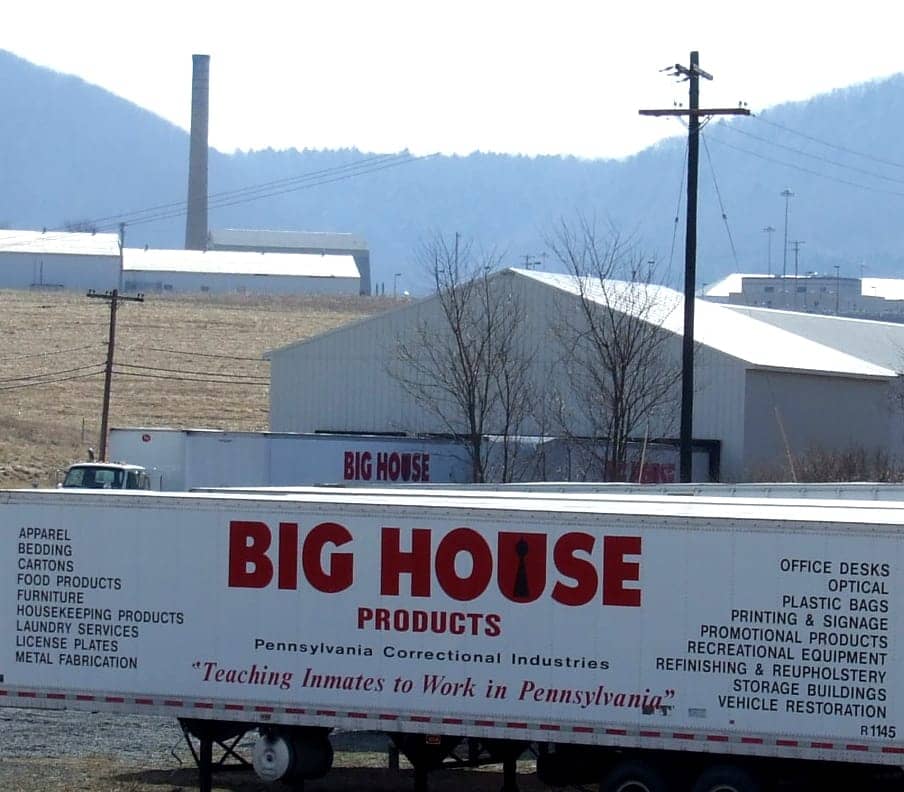
Prisoners in SCI Rockview who are not in solitary confinement work in the Big House Products factory manufacturing products used throughout the state. – Photo: Dave Bonta
Later the same day, during the distribution of food trays, guard Taylor exclaimed, “Who gets the loaf – Carter?” and began laughing. He then began “whistling Dixie” down the entire range. As he was leaving, he made the flat-line “beeeep” noise.
Corey Blanchard: “My main concern is whether they’ll continue to have these people working around us. Nurse Vicki, Julie, Amanda, Michelle – they’re all friends and didn’t like Carter. You never know; they could have purposely let him die.”
On the morning of April 28, guard Sherman grinned the entire day to provoke a response while we were coming in from yard. He and he only selected particular prisoners to ask, out of the blue: “Are you refusing to come in? We can easily call the CERT team.” Those asked included myself, Hankins and Rhem, not ironically.
Institutionalized terrorism
The murder of John Carter on April 26 is deeper than “a cell extraction occurred in the RHU and a man died.” His death exemplifies what Carter himself and many others have endeavored to expose for years: that solitary confinement is a dark hole where anything goes.
There is no accountability for rogue prison guards, and top officials turn a blind eye to the abuse, dismissing abuse claims in rote fashion. This only encourages the perpetrators to continue breaking the law.
The only difference between a street criminal and a prison guard is that the street criminal knows if he gets caught doing wrong, he’s going to prison, whereas the prison guards are part of a system that endeavors to uphold an image of professionalism. They will cover up and protect that image no matter what.
His death exemplifies what Carter himself and many others have endeavored to expose for years: that solitary confinement is a dark hole where anything goes.
Systematic practices throughout the entire DOC include, but are not limited to:
● a high presence of reject guards like Sherman, Taylor, McHenry and others who cannot function in population due to poor social skills;
● a misconduct system with a 99.9 percent conviction rate against prisoners and a 98 percent rate of rejecting all grievances filed against DOC stuff, as per the DOC’s own statistics;
● the encouragement of prisoner on prisoner violence, including suicide and sexual assault;
● retaliation against prisoners exercising their constitutional right to file grievances, criminal complaints and civil suits regarding conditions of confinement and prison guard/official abuse. Retaliation comes in the form of fabricated misconduct, placement or extended time in solitary confinement, destruction of property and denial of parole;
● failure to provide adequate physical or mental health care;
● frequent use of racial slurs, threats of violence, and verbal and physical abuse by the guards, which ultimately leads to cell extractions or other occasions for guards and officials to torture, abuse or murder; and
● the issuance of cold, inedible, sometimes frozen foodloaf as a tactic to starve prisoners.
There is no accountability for rogue prison guards, and top officials turn a blind eye to the abuse, dismissing abuse claims in rote fashion. This only encourages the perpetrators to continue breaking the law.
In one of my prior writings, I penned: “As the years passed, I came to overstand that a job as a prison guard only appeals to those who need to be controlled/instructed on what to do and not to do and are not leaders. They rise through artificial ‘rank’ systems of sergeant, lieutenant, captain, major etc. based on following written scripts on how to be a leader. They are not permitted to be innovative or let their individual characters shine. There is not much of a difference talking to a guard of the lowest rank or a warden or superintendent because the mentalities are the same.”
[Systematic practices are listed above. Specific practices applicable to Carter are listed below. – ed.]
● They continued shocking him after he was already subdued by the O.C. and the guards.
● Carter was already physically and mentally weak from being starved of food off and on for seven days.
● They kept Carter in the cell full of toxic chemicals, knowing he needed fresh air.
● They took an excessive amount of time to call for help after Carter stopped breathing.
The imbalanced equilibrium
Other facts which factored into Carter’s decision-making include:
● There is no legitimate avenue of relief or protection from abuse for the DOC prisoners. I have overheard him ask Blanchard rhetorically: “Do you know how many grievances, complaints and lawsuits we’ve filed? Between me, Hankins and Jacobs alone at least thousands.”
● Carter was locked in adult prison since the age of 14 serving a life sentence. If I understand his crime, he participated in a robbery in which the victim was accidentally shot and killed.
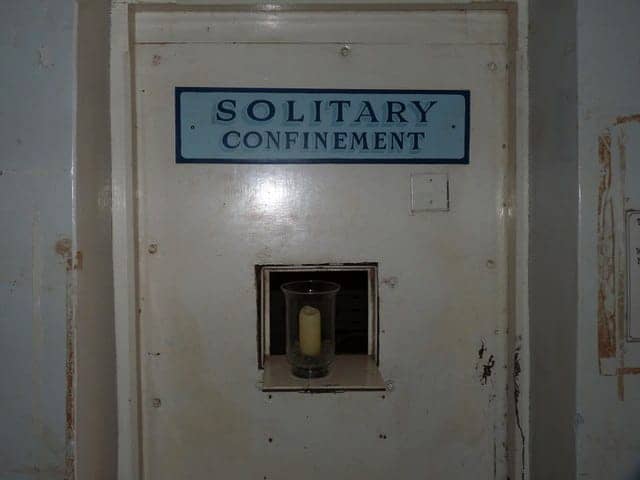
Prisoners are sent to “the hole” – solitary confinement – like this one in a Pennsylvania prison most often, they say, for protesting prison conditions, especially if they’re Black or Brown.
● He was unjustly placed in the Special
Management Unit (SMU), which led to his placement in solitary confinement indefinitely, a practice called Restricted Release List (RRL), which can be ended only with the approval of the secretary of the Department of Corrections.
● He spent years in solitary confinement witnessing and experiencing prison guard abuse without any accountability.
Before completing this report, I discovered the following:
● Guard Taylor (There are two Taylors monitored in this report: The killer is the father of the antagonist and potential killer.), who Carter allegedly assaulted on April 19, was a member of the cell-extraction team that killed Carter. This is attributable to a DOC and Rockview policy, practice or custom of refusing to issue separations between parties whenever it will inconvenience them. Hayden Marshall was in the law library while the cell extraction team was mounted and personally saw Taylor in gear.
● On May 1, while Hankins, Torres and Rhem were in the law library, Lt. Sutton processed in the RHU a new comment. He pointed an imaginary gun at these three prisoners and began “shooting,” indicating that they are marked for death.
● Ex-SCI-Rockview prisoner Mark Robinson has a pending lawsuit against Lt. Sutton for constitutional violations, possibly assaults.
● Ex-SCI-Rockview prisoner Steven Gravely has several incidents with Lt. Sutton, including possibly being sprayed.
● Current and severely mentally ill prisoner Allen Barnes was viciously and excessively sprayed with O.C. by Lt. Sutton.
● Lt. Sutton supervised and condoned an assault by prison guards on Robert Hankins in 2011.
● On his own accord and without approval of the dietician, Lt. Hardy literally cut the food portions in half, stating “make a move.” The entire RHU was in an uproar.
● On May 1, Sgt. Stitzer outright denied prisoner Rhem his dinner meal, along with guards McHenry and Sherman, who have repeatedly assaulted prisoners, myself included, as a team. While leaving the range, Sgt. Stitzer knocked on Carter’s cell door and said, “Hello? Is anyone there?” as they all laughed.
● On the same night, under Lt. Kern’s supervision, guard Glass slammed the arms of Anthony Bloom in the food slot and tried to fabricate a claim that Bloom assaulted him. The cameras were viewed, showing Glass had lied. While in the yard on May 2, I witnessed Bloom’s arms severely cut up and bandaged. Glass specifically boasted of Carter’s murder and called Bloom a “nigger.”
● During rounds on May 2, myself, Rhem, Hankins and Thompson all informed Superintendent Lamas of these events. I insightfully informed her that now that they have gotten away with a murder, other racist, hot-headed guards are seeing how much more they can get away with. I also informed her that I firmly assert my right to self-defense, as I have successfully done in the past.
After the murder of Carter on April 26, guard Sherman returned to work on April 28 without a care in the world. A total atmosphere of terror and intimidation has been created in an attempt to make prisoners afraid to expose the murder of Carter or otherwise make them afraid to give statements critical of Rockview if interviewed.
During rounds on May 2, myself, Rhem, Hankins and Thompson all informed Superintendent Lamas of these events. I insightfully informed her that now that they have gotten away with a murder, other racist, hot-headed guards are seeing how much more they can get away with.
If history and the shabby police work done is any indication, I foresee that Carter’s murder will be ruled accidental or justifiable and swept under the rug like all the other murders of RHU prisoners throughout the state of Pennsylvania. The abuse will continue until all are spiritually broken or moved to rebel, Carter will become a footnote, and racist, blood-thirsty guards will rear their ugly heads to kill again.
Pursuant to 28 USC §1746, I, André Jacobs, declare that this statement is true and based upon my own personal knowledge or belief. I certify that nothing in this writing is meant to mislead or deceive.
Signed: André Jacobs
“Man must not care how and where he dies, provided he dies at the post of honor and duty.” – Abraham Lincoln
Affidavit of Andre Jacobs on retaliation for protesting the murder by guards of John Carter
On June 6, 2012, I was returned from court to SCI-Rockview. Guard Baumgardner, who, within a two-week period before I left for court, had denied one prisoner a tray, assaulted another prisoner and threatened to kill me, immediately began going through my legal property, stating, “You won’t be seeing any of this for a while. I heard about the shit you wrote about me.” This was around 12 noon.
For the 2-10 shift, Lt. Graham and guards Archer, Weaver and Shoeman were working. I requested but was repeatedly denied my legal property, without any justification. The next morning, Superintendent Lamas said to me that I should consider recanting what I wrote in regards to the murder of John Carter. I asked her what does that have to do with me being the only RHU prisoner without in-cell property, noting that I am not on any restrictions. Lt. Hardy was present the entire time.
When I came out of my cell to go to the yard, Lt. Hardy asked me, “Have you reconsidered? We have your property out there right now.” I continued walking without responding. Upon my return from the yard to my cell, the guard holding the restraint tether began lightly squeezing my arm trying to provoke a response. I did not respond the entire time.
Failing to provoke a response that way, he then tightened the cuffs and pushed me in the cell. When I braced myself from falling, Baumgardner immediately screamed, “Stop resisting!” viciously grabbing the tether and yanking it through the food slot, and slammed the door. All three guards pulled on the cuffs as they were removed, causing bruising and swelling on my wrists.
I requested medical care from Nurse Lisa during medication distribution. She refused me medical care, denied me my prescribed medications and showed me a tattoo on the inside of her right wrist and stated, “You see this? I hate niggas for real. I can have you killed.” She said this openly and loudly for the entire tier to hear.
I was later seen by Nurse Asmirelda, who took pictures. To date I do not have any legal property.
Pursuant to 28 U.S.C. Sec. 1746, I swear under penalty of perjury that this statement is true and based on my personal knowledge and belief.
André Jacobs
Open letter to the family of slain comrade John Carter
by André Jacobs
Behind these walls, we honor John (J-Roc) Carter as a fellow soldier who died in the line of duty. He stood for a cause and went above and beyond the call of duty. John Carter was a warrior in a mission by the Pennsylvania Department of Corruption (DOC) to break his spirit so that his body would labor for the Prison Industrial Complex (PIC) without resistance.
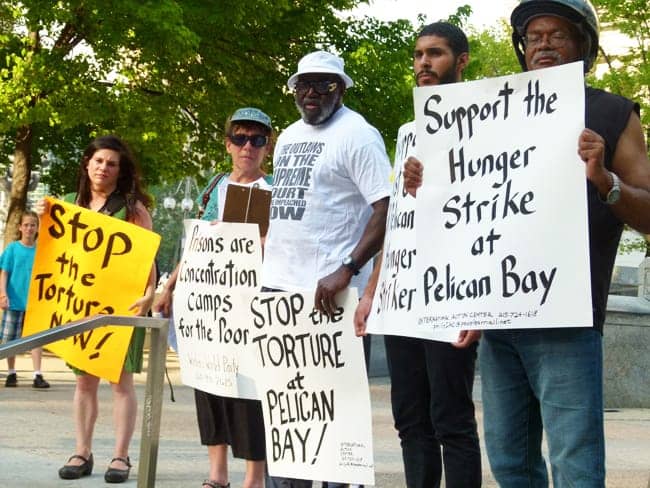
Pennsylvania activists who oppose solitary confinement rallied in Philadelphia on July 18, 2011, at the height of last year’s first California hunger strike. – Photo: Joe Piette
They could not kill his spirit, so they killed his body. These small minds fail to realize that J-Roc’s spirit lives on. His spirit is alive and breathing and shining brighter than it was before. A warrior’s spirit never, ever dies.
I met J-Roc at SCI-Houtzdale in 1998; he immediately stood out because he was the only juvenile with a voice as deep as singer Barry White. He wrote music, sang not so well and was a great rapper. To his dying day, he was awed by the fact that I remembered many of his songs from back then word for word. I connected with him because he was insightful, loyal and not too strong to show compassion. He was a fighter and stood firm on his beliefs.
Me and J-Roc were imprisoned together at SCI-Greene in 2001 but did not get to see each other. We were both aware by word of mouth that we were officially identified as threats by the oppressor as our minds elevated and we came into cultural, personal and revolutionary conscientiousness. We struggled and grew together without being in each other’s physical presence. For years, I was eager to see where his mind was and just how much he had grown.
Behind these walls, we honor John (J-Roc) Carter as a fellow soldier who died in the line of duty. He stood for a cause and went above and beyond the call of duty.
We met back up when I arrived here at SCI-Rockview in April of 2011. He wasn’t much taller but he no longer had the build of scrawny juvenile. I commented on his deep voice and he smiled. He congratulated me on a lawsuit I won against the DOC and we talked about law, politics, business, Black Panthers, struggle, pain and plans.
He was well rounded and I told him I was proud to see he had grown. I shared with him my vision for an entrepreneurial movement called “Supreme Network” and he said to me, “You know I’m all for the cause.” He told me he wanted to incorporate into it the fight for juvenile lifers in Pennsylvania and elsewhere. I promised him a meaningful position not because we were friends but because I knew that given the opportunity he would rise to the occasion.
One of J-Roc’s temporary goals was to get removed from the restricted release list (RRL) that caused him to be sentenced to die in solitary confinement. He gave me a copy of a lawsuit he filed which demonstrates that the biased DOC selected him for placement in the special management unit (SMU), which ultimately led to his RRL status.
While in the SMU, J-Roc, like many others, was subjected to every form of mental and physical abuse the oppressor has to offer those of us who refuse to accept slavery and torture in the form of assaults, food starvations, constant provocation, sensory and perceptual deprivation and mail destruction. It is like the story of Kunta Kinte.
They explore various methods to discover the one we are most vulnerable to. The only difference here is that J-Roc never broke. He stood for the cause knowing full well how diabolical and savage-like his enemies were.
If I know J-Roc at all, and we’ve spent many a day and night talking or debating, I know he has no regrets. His spirit is well and breathing, watching to see how the future unfolds.
J-Roc’s spirit lives on. His spirit is alive and breathing and shining brighter than it was before. A warrior’s spirit never, ever dies.
By this letter to you, I am making an undying promise to you that I will make J-Roc’s name live on forever. He was a well respected and decorated soldier in this war on Blacks and oppressed people and is held in high esteem. Every man, myself included, is prepared to die a thousand deaths. J-Roc believed that it is better to die on your feet than live on your knees.
The oppressor maimed and hurt J-Roc’s body but they can never, ever take his spirit from him or us. When you think of J-Roc, think of George and Jonathan Jackson, Martin and Malcolm, Sojourner, Ms. Parks and all of our other great warriors who walked their talk and transitioned with no regrets.
I am here for you in any way you need me. All my love, respect, loyalty and support.
In the Spirit,
André Jacobs
I think they killed a friend of mine
I think they killed a friend of mine
Yeah, I think it’s time
They dragged him out the cell limp
Shocked him seven times
Ripped the door off like madmen
Just to taste his blood
He was fine in his solitary cell
But then the O.C. poured in floods
I think they killed a friend of mine
Yeah, I think it’s time
It was enough chemical spray to slay a lion
They pumped it hard like ghost busters
I heard ‘em scream, “Call 911!”
About 20 minutes later
Sprawled out on the floor as if a worthless rag
No one there to cater
I think they killed a friend of mine
Yeah, I think it’s time
The medics took a half an hour at least
The nurses dragged their feet
While trying to revive his silent heart
But couldn’t get it to beat
I think they killed a friend of mine
Yeah, I think it’s time …
Part II
I know I said they “killed” my friend
But, nay, he didn’t die.
They maimed and killed his physical body
But his spirit is still alive.
I know because I feel its warmth
Like fire that shines so bright
And gives the comrades strength to fight
An energy as vital as life.
He took them to their knees, I say
Because they profess to be upright
But let us not say they killed this man
And no one needs to cry
Just tilt your hats and honor his strength
Because warriors never die.
